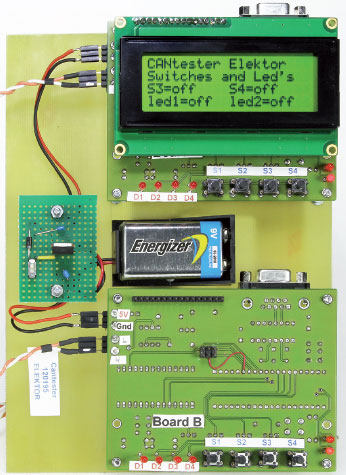CAN Tester
With comprehensive features

This is a MEMBER ONLY article. You need a subscription to read this article.
- Access to Elektor archive and 5,000+ Gerber files
- Receive up to 8 magazines per year (digital and/or paper)
- 10% discount in the Elektor store
Available from €4.95 per month.
What is Members Only
Elektor is committed to providing high-quality content on electronics, catering to tens of thousands of paying members. As part of this commitment, Elektor has launched Premium, an initiative that offers exclusive online articles to members sometimes even before they appear in the magazine.
Every day, members can access in-depth articles that showcase the best of Elektor's premium content.
This initiative aims to reward members with early access. Once logged in, members can easily enjoy this exclusive content and engage in discussions about featured projects. While Premium adds to the existing resources available, Elektor will continue to provide a wealth of free information.
Join the Elektor community today to take advantage of Premium and other benefits!
Gerber file
CAM/CAD data for the PCB referred to in this article is available as a Gerber file. Elektor GREEN and GOLD members can exclusively download these files for free as part of their membership. Gerber files allow a PCB to be produced on an appropriate device available locally, or through an online PCB manufacturing service.
Elektor recommends the Elektor PCB Service service from its business partner Eurocircuits or AISLER as the best services for its own prototypes and volume production.
The use of our Gerber files is provided under a modified Creative Commons license. Creative Commons offers authors, scientists, educators and other creatives the freedom to handle their copyright in a more free way without losing their ownership.
Component list
Resistors
R1,R2,R5–R8 = 1kOhm
R4,R11 = 10kOhm
R3,R9,R10 = 120Ohm
R12 = 330Ohm
P1 = 10kOhm trimpot, e.g. Bourns 3386P-1-103LF, Newark / Farnell # 9355030
Capacitors
C1–C4 = 22pF
C5–C9 = 1µF 63V radial
Semiconductors
D1–D6 = LED, red, 3mm
IC1 = ATmega8515-16PC, programmed, Elektor Store # 120195-42a for board A, # 120195-42b for board B
IC2 = MAX232ACPE
IC3 = PCA82C250 (8-pin DIP) or PCA82C250T (SO8, adapter board required)
IC4 = SJA1000 (28-pin DIP) or SJA1000T (SO28, adapter board required)
Miscellaneous
X1 = 8MHz quartz crystal
X2 = 16MHz quartz crystal
LCD1 = LCD, 4x20 characters (Elektor Store # 120061-73)
K1 = 16-pin pinheader, 0.1’’ pitch
K2 = 6-pin (2x3) pinheader, 0.1’’ pitch
K3–K6 = 3-pin pinheader, 0.1’’ pitch, with jumper
K7 = 9-way sub-D socket, right angled pins, PCB mount
K8,K10 = 2-way PCB screw terminal block, 0.2’’ pitch
K9 = 2-pin pinheader, 0.1’’ pitch, with jumper
S1–S5 = miniature pushbutton with make contact, e.g. TE Connectivity 3-1437565-0, Newark / Farnell # 2060813
PCB # 120195-I, see [1]



Discussion (0 comments)